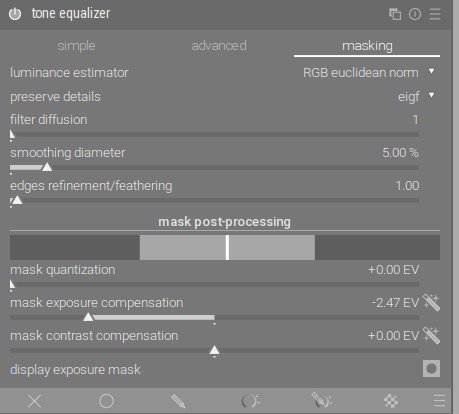Well most raw software can so it’s clearly and empirically possible.
Nope. When channels are clipped, you loose that data.
Sure you can guess what should be there and put data in there, and darktable is weak here (but new goodies coming), but its still a guess and the application is inventing data that isn’t in the raw file.
I think this discussion has slipped into highlight recovery which is part of the same problem of managing highlights but is still a distinct issue that I know you are working on.
Filmic is getting increasingly better but it’s still difficult to control the highlights of the global tonemapping. I agree that you have limited “space” to do so but It’s usually enough and workable with a more flexible curve. I understand that filmics answer to the issue is local tonemapping with the tone equaliser?
Yes, or masked exposure module.
OGM NOOOOOO. I have explained that, and Boris has shown you the graph.
Stop with wishful thinking, any curve will give you the same result because it’s constrained in 3 points and display peak white is 100% while diffuse reflective white is 92%. 8% is 0.12 EV for specular highlights and emissive stuff.
No bloody global mapping, no curve, no one-size-fits-all method will give you that.
USE LOCAL TONE MAPPING.
Second color calibration?
Yes. Second instance. First is for white balance, since I use gradient mask in second one for darkening the sky.
Yes, but you called it color balance. Don’t you mean color calibration?
Yes. I corrected it. Sorry. 
Yes, tone ecualizer, but with tone eq I have a problem many times:
when you select any patch in the sky all of them are in the last step of the curve.
So you cannot expand the highlights using a toot that has no control points to separate that tones.
May be it is due to the linear scence processing, but then in tone eq nodes should be not equally spaced or be shown in a logarithmic scale with morre controls in the highlights.
Your image is underexposed in general terms to not burn highlights.
And you use exposure to compensate it and the tone eq to revert it and expand lights with good result.
But that image is not backiluminated and has not so much DR than a sunset or when the subject is in the shadows.
When you have the sky overexposed (let us keep the clipping effects apart and thinkg of an image with no clipped channels).
May it be that the opposite path works?
I mean lowering exposure a bit, and using tone eq to adjust?
The use of color balance to darken the sky is providing a good improvment for the photos I have tested, thank you.
I would not like to keep talking about highlight recovery here, as it really does not too much relation with tone mapping or sigmoid vs filmic comparation.
But it @anon41087856 local contrast technics in gamma compensated work flow can produce halos, but usually in high contrast border thansitions.
Usually are selections and strong tonal changes what produces your halos.
In a sky that LR or other software recovers from one or two channels being blown you have not that problems (except if you are really mad at dramatization).
In clouds or sunsets there are no hard borders or abrupt transitions, so recovering color from neighbourhood and aplying info about luminosity from the remaining channel usually does not work bad.
In any case it works much better than having a grey patch or a magenta color where it should be a not so saturated yellow.
If that is so like here…
…then you go to the masking tab and adjust the mask…

![]()

…and now you have it:
![]()
The photo is a little blurry but, before:
After:
Also done as I have described above.
Yes.
Great, thank you.
Have to study it and do tries to see if I can master it.
I will put this thread in my bookmarks bag.
In my image, all samples from the sky are over the last node to the right.
But I had not used the mask postprocessing options.
One more thing to study and master, thank you.
Again these settings and the chosen norm can impact the mask and the end result quite a bit so it is good to experient…esp is you see any halos the edge slider can be used to clean them up…
That’s a great tutorial, Boris. I see how you used the master tab in Color Balance RGB to increase contrast, but it begs the question as to why the 4-ways isn’t used very often for that purpose?
Thanks for doing all the screenshots… I never learned so much in 5 minutes before.
Because the contrast you can get in the master tab by increasing the saturation is sufficient in most cases.
I use it in color balance rgb.
In fact that was my previous way of doing thins, playing with the silders to affect only highloghts and using a mask.
The effect is simply not enough strong to be very noticeble and counteract the inevitable strong compression of highlight in the tone mapping step made by filmic or any other curve.
Stupid question: Is sigmoid doing anything beyond the equivalent of the “Look” tab in filmic? Is it a look tab replacement or something much more complicated? Edit: I see now, again, how intertwined the look and scene tabs are in filmic.



